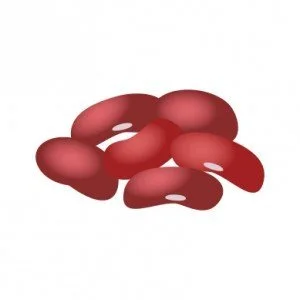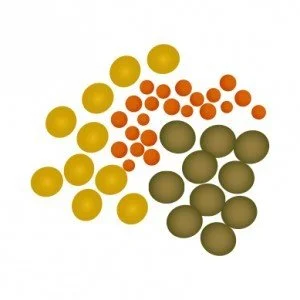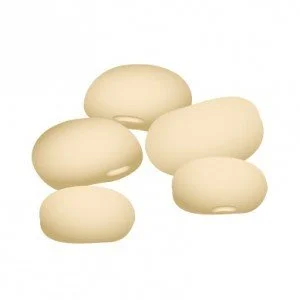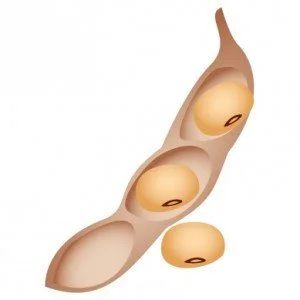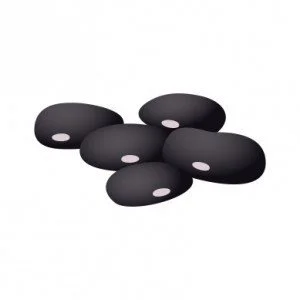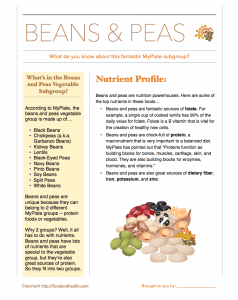MyPlate Exploration: Beans and Peas
This may be my favorite MyPlate vegetable subgroup.Beans and peas are unique because they can belong to 2 different MyPlate groups -- protein foods or vegetables. Basically, you can count them as whatever you need them to be the most. If you get plenty of vegetables, count beans and peas as protein foods. If you're looking to increase your veggie consumption, then count them as part of the veggie group. As part of our exploration today, beans and peas are going to be part of the vegetable group -- they're even their own veggie subgroup!To catch up on the previous MyPlate explorations, check out...
And now let's get to the next section: beans and peas.What's In the Beans and Peas Vegetable Group?MyPlate has listed the following veggies as part of the beans and peas group...
Black Beans
Chickpeas (a.k.a. Garbanzo Beans)
Kidney Beans
Lentils
Mature and Dried Black-Eyed Peas
Navy Beans
Pinto Beans
Soy Beans
Split Peas
White Beans
So, why are these beans and peas considered welcome in either the protein or the vegetable food groups? It all comes down to their nutrients. According to MyPlate...
These foods are excellent sources of plant protein, and also provide other nutrients such as iron and zinc. They are similar to meats, poultry, and fish in their contribution of these nutrients. Therefore, they are considered part of the Protein Foods Group. [...] However, they are also considered part of the Vegetable Group because they are excellent sources of dietary fiber and nutrients such as folate and potassium. These nutrients, which are often low in the diet of many Americans, are also found in other vegetables.
Lentils
So there you have it -- beans and peas are welcome in two worlds! Now let's take a closer look at those nutrients...What Nutrients Do These Vegetable Contain?*Beans and peas are nutrition powerhouses. Here are some of the top nutrients in these foods...Beans and peas are fantastic sources of folate. Take lentils, for example. A single cup of cooked lentils has 90% of the daily value for folate. That's huge! Many other beans and peas have over half the daily value of folate in a single cup -- think chickpeas, black beans, black-eyed peas, white beans, and kidney beans. Even soy beans, with the lowest folate content of the bunch, still weigh in at 23% of the daily value.In addition, these beans and peas are great sources of protein. Here's a rundown of the daily value of protein that you can find in these beans...
Soy Beans: 57%
Lentils: 36%
Split Peas: 33%
White Beans
Kidney Beans: 31%
Black Beans: 30%
Chickpeas: 29%
Navy Beans: 29%
Black-Eyed Peas: 28%
Pinto Beans: 23%
Navy Beans
Dietary fiber is also a serious contender in the beans and peas MyPlate vegetable subgroup. White beans have the most fiber, with 74% of the daily value for fiber in a single cup, but split peas, lentils, and black beans are also of note with 65%, 63%, and 60% of the daily value, respectively. Navy beans have 53%, while chickpeas have 50%. The roundup continues with kidney beans (45%), pinto beans (44%), soy beans (41%), and black-eyed peas (25%).While all beans do contain at least 14% of the daily value for iron, the top 5 sources in this subgroup are soy beans with 49%, lentils with 37%, black-eyed peas with 29%, white beans with 28%, and navy beans with 27%.If you need a potassium boost, then soy beans are perfect for you. With 25% of the daily value for potassium in one cup, these beans are a great way to get more of this nutrient of concern. Soy beans aren't the only sources of potassium, however. Here's a look at the potassium content of the other beans and peas...
White Beans: 24%
Navy Beans: 22%
Lentils: 21%
Kidney Beans: 20%
Split Peas: 20%
Black-Eyed Peas: 18%
Black Beans: 17%
Pinto Beans: 17%
Chickpeas: 14%
Finally, there's zinc. Who could forget zinc? Black-eyed peas are the best source of zinc in the beans and peas group -- they have 21% of the daily value in a single cup. Chickpeas and lentils are next in line, with 17% of the daily value, and the rest of the beans and peas have between 13% and 11% of the daily value.
What are the Health Benefits Associated with Beans and Peas?
These nutrients do more than make impressive statistics. They also offer health benefits.
Take folate, for example. Folate is a B vitamin that is soluble in water. It's vital for creating healthy new cells and especially important for women of childbearing age. It also keeps the blood healthy. If people don't get enough folate, they could develop anemia.
Iron is also vital for the prevention of anemia, a condition that results in low energy levels and fatigue. Luckily, beans and peas are great sources of iron, which is also vital for the creation of red blood cells. According to the Centers for Disease Control and Prevention (CDC), "Iron is a part of all cells [...] as part of the protein hemoglobin [iron] carries oxygen from our lungs throughout our bodies. [...] Iron also helps our muscles store and use oxygen. Iron is a part of many enzymes and is used in many cell functions. Enzymes help our bodies digest foods and also help with many other important reactions that occur within our bodies."
Plus, these beans and peas are excellent sources of potassium. We've discussed the health benefits of potassium at length in the Red and Orange and Starchy vegetable posts, so check out those links for an in-depth review. For now, let's hit the highlights. Most people don't get enough potassium, vital for sodium regulation, normal growth, heart health, food processing, and preventing bone loss. Beans and peas are great sources of potassium, so add them to your diet today!
But wait, there's more! Beans and peas are chock-full of protein, a macronutrient that is very important to a balanced diet. MyPlate has pointed out that "Proteins function as building blocks for bones, muscles, cartilage, skin, and blood. They are also building blocks for enzymes, hormones, and vitamins." Numerous studies have been done that explore the impact of protein from plant foods on health. Shall we take a look at one of them? The Health Benefits and Risks of Plant Proteins, led by M. Krajcovicova-Kudlackova, K. Babinska, and M. Valachovicova, found that "A sufficient consumption of plant proteins has the protective effects against chronic degenerative diseases."
You know what else protects against chronic disease? Fiber. And since fiber is such a key part of beans and peas, let's take a moment to explore its health benefits. As you may remember from the Starchy Vegetable post, MyPlate has asserted that “Dietary fiber […] helps reduce blood cholesterol levels and may lower risk of heart disease. Fiber is important for proper bowel function. It helps reduce constipation and diverticulosis. Fiber-containing foods […] help provide a feeling of fullness with fewer calories.” By providing a feeling of satiety without requiring a ton of calories, fiber can help with successful weight control, which can help people lower their risk of a variety of chronic diseases. Plus, by reducing constipation and diverticulosis, fiber can stave off damage to the colon, and let's face it, no one wants anything to go wrong with that!
How Can I Eat More Beans and Peas?
Here's where the fun begins. These beans and peas aren't great raw -- they're dried and hard. Cook them with some aromatics in a pot of boiling water until they're tender, or get canned/frozen varieties for a speedier way to add beans and peas to your meals. Just be sure that the canned/frozen ones are low in sodium and other added ingredients.
Check out recipes online, including the ones in our free and member sections.
So, what did you think? If you like what I've written, check out some of the excellent nutrition and health education products in the Nutrition Education Store. All of the products are based on the latest scientific research...* Data from http://nutritiondata.self.com. Applies to 1 cup of cooked or canned beans.




